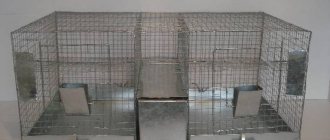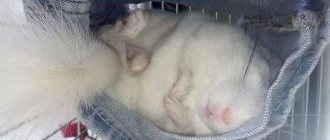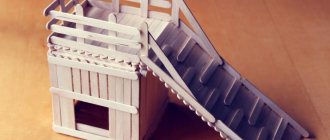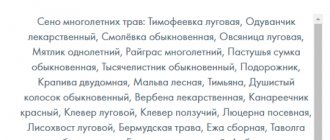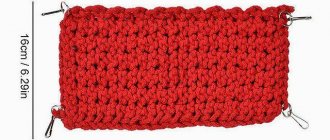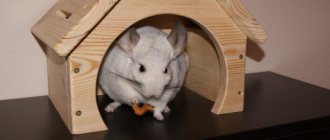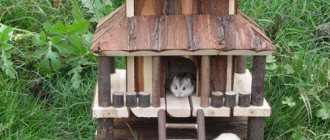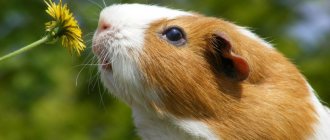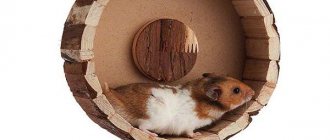Chinchilla house: purpose and installation
A home for a furry pet is not just a beautiful addition, but an integral attribute designed to make its contents cozy and comfortable. After all, a rodent should have its own personal space where it can hide from prying eyes, eat its favorite treats and just relax.
The house should be placed in the darkest corner of the cage so that the chinchilla can rest during the day.
A home for chinchillas is also necessary if the owner plans to breed these animals. A separate home is necessary for a young female chinchilla. A new mother needs a personal home where she can care for her offspring without supervision.
As for the location of this accessory, it should be placed in the least lit corner of the cage. Chinchillas tend to sleep during the day, and it is important to have twilight in the house during the day.
Important: for greater safety and stability, it is better to place the house at the bottom of the cage. If the owner wants to mount the house on a shelf or buy a hanging house, it should be carefully attached to the rods so that the rodent does not fall from it and get hurt.
Soft, cute, gnawing: who is it?
Chinchillas are cute rodent pets famous for their warm, dense fur and adorable faces. They are bought by those who want to make their home more comfortable, because these animals are so cute! But we must not forget that this furry creature also needs comfort and coziness. Therefore, you can make a cute house for a chinchilla in which the animal will feel safe.
Chinchillas are crepuscular animals, so a cage house will be very useful so that your pet can hide there during the daytime and take a good nap. A home for a chinchilla is as necessary as a bed for a person, so don’t skimp on such important little things.
Types, shapes and types of houses for chinchillas
Wood is most often used to build houses, but such accessories are also made of ceramics or plastic. Sometimes you can see original houses for rodents made of straw or rope.
However, the most popular homes among furry pet owners are still wooden houses, as straw, plastic and string products are not durable.
When it comes to shape, houses can be round, triangular, oval and rectangular. Housing for chinchillas is made in the form of country huts, medieval castles and even Indian wigwams.
Which model to choose depends on the personal preferences and financial capabilities of the owner.
However, before you offer your pet such an accessory, you should know what criteria to follow when choosing a home:
- The size of the house should be chosen according to the size of the rodents. The chinchilla should fit freely into its home and not experience discomfort due to cramped space;
- The structure should be free of small holes where your pet's paw could get stuck;
- It is recommended to choose a product with multiple windows so that enough fresh air can enter the house;
- It is better to buy a bottomless chinchilla because it is easier to clean;
- The roofs of houses in the shape of pointed domes are beautiful and original, but they are not safe for pets. A curious rodent that climbs onto such a roof can slide off and injure itself. Therefore, it is better to choose a flat top structure;
- There should be no small parts in the chinchilla's house that can be swallowed (nails, screws).
Important: If there are several furry animals in a cage, each of them must have its own home, otherwise fights between animals cannot be avoided.
Requirements for the house
So let's look at what it should be. What are the requirements:
- It doesn't have to be small or big. The most optimal size is 30x20x20 centimeters for one resident.
- During production, take into account the fact that you will need to clean there.
- The chinchilla loves to rest on the roof of the house, so take this into account and make it flat.
- Make the house safe for your pet; if any parts are involved, secure them well.
- Use only environmentally friendly materials, otherwise your animal may die. It is best to use high-quality plywood or boards.
- If you make holes, keep in mind that it must be of normal shape, otherwise your pet could get stuck there and get injured.
- Make an additional window for ventilation.
- Check that there are no protruding elements in your house, such as nails or screws. Otherwise, the chinchilla may be injured by them.
DIY chinchilla house
Of course, you can buy a chinchilla in specialized pet stores, but there are several risk factors that can be very unpleasant:
- Size. As your pet grows, at some point the size of the house may no longer suit you and your chinchilla.
- Materials. Chinchillas are rodents, and their tendency to chew everything they can get their hands on is no less than that of hamsters. A store-bought chinchilla house will most likely be made from materials that could infect your pet if he "tastes" them.
- Design. Refined owners love to pamper themselves and their little friends with something special, so it makes sense to make a chinchilla with your own hands in order to fully adapt it to the needs and whims of the animal.
So, the decision has been made, the decision has been made. There is only one question left - how to make a chinchilla with your own hands?
Materials
First of all, you can't get out of your head the fact that sooner or later (and sooner and later) your chinchilla will transfer his future "room" to his teeth. Don't be upset, it's inevitable!
In addition, chinchillas cannot be weaned from the habit of chewing - it is a deep instinct. The best solution is to sit down, calm down and think: what should the house be made of so that the animal’s body does not suffer during the digestion process?
First of all, throw away materials that definitely shouldn't be used!
- Plastic. Your pet's belly will definitely not thank you for this.
- Dye. Very dangerous, can cause poisoning.
- Cardboard. Absolutely useless material when it comes to rodents. In this case, the animal will receive not a home, but an exotic dinner.
- Glue.
A strict taboo on all of the above!
But these materials are quite safe and would be great for a makeshift home:
- Dry wood.
- Aluminum.
- Unpainted metal.
- "Stainless steel.
- Glass.
The easiest option for beginners would be a wooden chinchilla. However, before you start cutting some inspiring boards, you need to do a little preparation.
Preparation
Start with size. A chinchilla's home should be at least 10 cm larger than the chinchilla itself for the animal to feel comfortable there. Chinchillas have an average body length of 22-38 cm and a tail length of 7-15 cm.
If your pet hasn't grown up yet, doesn't live with you, or for some reason you can't measure it, it's better to choose a larger size—it's better to "fake it" than to "fake it."
After determining the dimensions, it is worth thinking about what the future home will look like. This can be a simple “box” with an arch and a window, if the size of the cage does not allow it to be stretched; For tall cages, a good solution is to create a "storage" house with shelves in the middle so that the chinchilla can jump up and down on them.
For those who have several chinchillas in one cage, a labyrinth will be an excellent arrangement option - it will divide the space into cubicles so that the animals can take a break from each other in case of conflicts.
Having imagined your future home in your head (and on paper), start building. To do this you will need the following tools:
- Ruler.
- Regular pencil.
- Wooden boards.
- Drill and drill with chisels.
- Hammer.
- Electric jigsaw.
- Furniture fittings.
- Grinder machine.
First option: making a simple wooden house
This is a simple version at home that you can make yourself.
How to make a house:
- The rodent's apartment should be spacious, so first calculate the size of the house by drawing the measured outlines with a pencil. The approximate dimensions of a house for one medium-sized chinchilla are 270 mm * 180 mm * 156 mm.
- Cut out the walls and roof.
- On the front wall, draw silhouettes of the entrance and window. You can also make windows on the side walls.
- Holes are cut along the planned contour.
- Sand the edges of the prepared pieces, including the cut out windows and entrance, to make them flat and smooth.
- To avoid the use of glue, dowel holes are drilled in the walls and roof.
- Secure all parts to each other with dowels.
- Your pet's gift is almost ready, all that remains is to wipe it with a cloth soaked in water and a few drops of alcohol or vinegar to disinfect it.
- The apartment is then drained and vented, and the house is placed in an animal cage.
- To make the house more durable, you can line it with metal, as the chinchilla will bite it.
Here's how you can protect your home from chinchillas' sharp teeth.
Third option: making a house in the shape of an arch
This is the type of onion house that you can quickly force yourself to do.
For this we need:
- A sheet of plywood 2 cm thick;
- small boards 3 cm wide and 2 cm thick;
- compass and ruler;
- grinding machine;
- teachings;
- pegs.
Implementation instructions:
- On a sheet of plywood, using a compass, draw a circle with a radius of 14-16 cm.
- Cut out a circle and divide it into two equal parts. This will be the back and front wall.
- On the front wall we saw a window and a door.
- Sand the edges of the parts.
- Cut the strips into pieces 18-20 cm long. Grind.
- Using a drill bit, drill holes for the dowels in the moldings and around the perimeter of the walls. The distance between the holes is 3 cm.
- Assemble the product.
Important: Chinchillas can try their new home on their teeth, so do not use oak to build your home. The bark of this tree contains tannins that cause severe diarrhea when ingested by rodents.
Second option: making a two-story house
Based on the first method, you can build a two-story house. To do this, build one larger house than in the previous example, and one smaller one, and then combine them.
We will have a house like this.
Last step: building a house for the chinchilla!
To begin with, we saw the boards and turned them into walls and a roof in accordance with the dimensions we already knew. The edges are sanded, but some chewers like to sand their own at home, so unless you crush the wood while sawing, you can leave the job to your pet.
Before you start assembling the house, you need to cut out the arch and window. To do this, you need to draw their outlines on the walls with a pencil: the shapes and sizes can be any, it all depends on your imagination. But if you don’t know how to lay out, it’s better not to be too zealous and limit yourself to simple shapes: circle, square, etc.
Once the windows and doors are cut out, you can begin installation. Connect the walls using pegs - wooden rollers. They can be purchased at DIY stores.
To connect the walls, you need to drill several holes in the side wall and the roof into which the dowels are driven. Attention: the diameter of the holes must be 1 mm less than the diameter of the dowels! If the difference in diameters is greater, then the project will not stick; otherwise, the dowels will either not fit or the wood will split.
PS To ensure that the dowels fit snugly into the holes and the chinchilla parts fit snugly against each other, tap the walls and roof with a hammer. Slowly!
Finally, you can sand the house with soft sandpaper.
If you are confident in your craftsmanship, you can try to create a more "luxurious" home: balconies, stairs, shelves, carved roofs, floors, etc. - any options that will attract you and the furry homeowner.
By the way, the lid does not have to be in place - it can be removed for easy cleaning of the cage.
PS Don't paint the house! The animal may be poisoned.
Here it is! The simplest chinchilla house from your own hands is ready. Make your pet happy and don't be afraid if he suddenly starts "eating" your house. Even if he makes a few extra windows. The main thing is not to skimp on high-quality materials that can withstand strong pressure from rodents with dignity and not harm the animals.
House assembly
After all the preparatory procedures, they begin to assemble the house. They start by marking holes on the boards for future fastenings and cutting them out with a jigsaw. The boards can be fastened to each other using ordinary furniture dowels. For greater reliability, the hole for the dowel is drilled a millimeter smaller than the diameter of the wooden cylinder. However, a very large difference in diameter can cause the board to split. Assembling the house begins with the walls to which the balcony is attached. The roof is assembled from two slopes at an angle of 45 degrees. The roof is attached to the gable using four dowels. The roof can also be made straight or at a slight slope, which will allow the pet to use it as an additional resting area. It is better to use a metal mesh with a very fine cross-section as the floor, or install the house directly on the floor of the cage.
It is also important to think about how to make the house safe. All sides, grooves and seams of the housing must be well sanded using sandpaper.
But painting the house is not recommended - chinchillas will gnaw at their home, this is inevitable, and paint particles getting into the stomach will lead to severe poisoning.
Article on the topic: Do-it-yourself chinchilla cage - step-by-step instructions with drawings and photos
It is also not recommended to use metal staples or nails in production.
Advantages of a house with a balcony
- Two entrances (main and from the balcony) allow the animal to feel safer,
- The balcony provides more opportunities for both games and relaxation,
- Inside the house there is twilight all the time, which will allow the animal to rest even during the day.
Why do chinchillas need a wheel?
It is used both as a toy to help pass time and as a training device to prevent muscle atrophy. Increasingly, owners are purchasing these products just for added entertainment for their pet, without considering the real needs and required functionality of their pet.
Since each of the above options has a large number of disadvantages, we will consider a self-made wheel for chinchillas and determine the necessary tools and materials.
You will need:
- teachings;
- Crosshead screwdriver;
- electric jigsaw.
- Tension bearing from the Volga (can be purchased at an auto parts store);
- M12 screws - 2 pcs. (short);
- 7 bolt washers and 4 nuts;
- drill 12 mm;
- small screws - approx. 50 pcs. (length no more than 3 cm);
- Plywood - 2 pieces 8-12 mm thick, square sheets;
- wooden profiles - 5 pcs. (length 1 m).
Start by preparing the table. You need to place an unnecessary base - chipboard, fiberboard or cabinet doors. Using a drill, make a hole in this base that will later be used to secure the plywood.
Next, screw the self-tapping jigsaws to the base, having previously made a hole where the saw will come from. The distance between the hole made by the drill and the hole under the saw will determine the diameter of the circle. In our case it is 15 cm.
Important: The board used as a base must be long enough and placed on stable supports. It cannot be screwed on.
- Before you begin, remove the jigsaw to help you get the job done. Then draw two lines, longitudinal and transverse, on the plywood sheets to find the center where the hole should be drilled.
- Make a hole on the plywood sheet with an electric jigsaw at a distance of 15 cm from the center. On another sheet, make two holes: one at a distance of 15 cm from each other, the other at a distance of 12-13 cm from each other.
- Then attach the single pass sheet to the base using a short bolt, nut and washer. Tighten until the sheet can be rotated. Flip the base plate over to attach the jigsaw. Then turn it over again so that the attached plywood is on top and the screwed jigsaw is on the bottom. Plug the device into the outlet and make sure it is securely attached.
- Then start the jigsaw and slowly turn the plywood in a circle. The result should be a circle with a smooth edge. Unplug the machine, remove the wheel, remove the jigsaw and repeat with another piece of plywood.
- In the second case, we first get a circle, and then a thin circle, the thickness of which is equal to the distance between the holes made under the jigsaw.
- Next we move on to doing the circle steps that will connect circle to circle to form a circle. Take the wood sections and then cut them into equal lengths. The length of the segments determines the depth of the circle, so the reference point is the thickness of the rodent's body. In our case, the length of the wooden segments is 15 cm.
- The next step is to varnish all the woodwork, then air dry and ventilate it to completely remove the odor.
- Screw the wooden circle to the base, then position it vertically to make it easier to screw the wooden segments together. Then attach each wood block first to the circle and then to the perimeter. The end result should be a circle with a completely smooth inner surface and a ladder structure on the outside.
- As a final step, insert a bolt and washer from inside the center hole of the wheel that will be used to secure the wheel to the cage wall. From the outside, screw the nut onto the bolt. Then install the tension bearing on the cage and insert the screw into it. The wheel should rotate easily and quietly.
This is the end of the production process. If you want to make a wheel with a foot, then simply take two wooden boards, connect them perpendicular to each other, and then attach the moving part.
It is very interesting to look at the running wheel and, probably, every owner will want to buy such a toy for their chinchilla. But is a chinchilla necessary? How useful is this? Or do wheels harm a chinchilla's health?
Let me start by saying that not all chinchillas love wheels. There are chinchillas that do not run on wheels at all, and there are also those that do not want to get out of them. Wheels certainly have their advantages. The undoubted advantage of the wheel is that it allows you to keep your muscles in good shape; physical activity is beneficial for chinchillas.
When choosing a wheel, pay attention to its size. Running in a wheel with a small diameter is harmful to the health of a chinchilla. The minimum wheel size for chinchillas is 32 centimeters, but for some larger chinchillas this is not enough.
Of course, if we have the opportunity, it is better to choose a wheel with a diameter of 40 centimeters, but it is impossible to find such a wheel in stores. But craftsmen who make custom-made furniture for chinchillas can help you.
One of the most common options is plastic wheels. In my opinion, they are the safest of those sold in stores. However, they are also the most expensive.
Read also: Disinfectants for forests: what types of animals clean the environment.
Wheels with metal bars and mesh can be traumatic for chinchillas. One careless movement and the result is a broken paw or finger. To prevent this, they are lined with thick denim, and the sharp edges of the metal parts are sanded.
Be careful, some types of wheels may not harm the chinchilla running in them, but the chinchilla that may be in the wrong place at the wrong time. Therefore, when choosing a wheel, think about how safe it is, how it is mounted in the display case, and so on.
When choosing wooden models, consider the nature and purity of your chinchilla. Some chinchillas may use them in their litter boxes, and because wood absorbs moisture..... From there it's all clean.
The most ideal option, in my opinion, would be a durable aluminum wheel with a diameter of 40 cm. Such a wheel can be ordered in the USA. But this wheel also has a drawback - the price. Not everyone can afford it, but nothing is too expensive for chinchillas.
And finally, I want to tell you about the catwalks. This is the one I've been using lately. It's safe and convenient. My plate is made of plastic, but there are also aluminum running plates on the market. This is the preferred option, but.....
Chinchillas are very active rodents that prefer an active lifestyle to a calm one. Especially if the owner has fun with them: he invents entertainment and builds various toys for chinchillas. Read more about them below.
You can find many different pet rings on the shelves of pet stores. They differ in color, shape, material and, of course, price. The cheapest are accessories made of plastic, then metal and wood. Rarely, but nevertheless, there are products made of plexiglass and ceramics. However, such accessories for pets are many times more expensive.
Sports equipment for your pet can be made from almost any material. However, when choosing a base, it is important to consider that each of them has its own advantages and disadvantages.
Table 1: Materials for corresponding chinchilla rollers
| Type of material | Characteristics |
| Plastic products are the best option for rodents. Chinchillas do not bite it, which means that the device will last a long time. You can't get hurt on a plastic steering wheel. In addition, the running wheel made of this material is very light and can be easily removed and disinfected. And in stores this device is relatively inexpensive. However, plastic wheels are not without their drawbacks - their size is mainly suitable for small animals or chinchillas: adults are unlikely to fit in them. | |
| Tree | A wooden ring is a good option for rodents. The design is made from environmentally friendly material and has no honeycombs or sharp edges, meaning there is minimal risk of injury. However, wooden products also have their drawbacks: wood quickly absorbs moisture and dirt and therefore quickly deteriorates. It is almost impossible to clean the wheel of feces and urine, so you will have to put up with the unpleasant odor coming out of the “trainer”. The tree also attracts rodents as a treat - they will nibble on the wheel rather than ride in it. |
| Metal | Metal wheels are not a solid material, but a mesh product - this makes the structure lighter. However, this makes the wheel traumatic: very often small paws, hair or claws get caught in the holes. Therefore, many owners of these wheels try to protect their pets by wrapping the inside of the wheel with a thick material (such as denim) that will prevent little paws from getting through the holes while running. |
Regardless of whether you decide to buy a ready-made wheel or make it yourself, it is important that it is, above all, of good quality. The requirements for products intended for use on animals are as follows:
- All parts of the wheel must be smooth and even. No chips, sharp edges or cracks are allowed;
- the wheel should be light so that it does not run over the animal in case of a coup;
- It is better to clean the wheel material from paint and varnish;
- The size of the circle should be one and a half times larger than the chinchilla;
- If the wheel is made of metal, then a grid or horizontal bars made of wood or aluminum should be placed on the running surface;
- It is best to install the wheel on the wall rather than on the floor. If the exercise machine is installed at the bottom of the cage, one chinchilla may hit the spinning wheel while running and injure itself.
What is a house for?
Chinchillas are animals that love secluded places. There were cases when the little animal did not have its own secluded corner, and it fell into depression and then fell ill.
A house for any creature is a place where you can rest, sleep and relax, there will not be any further disturbances or disturbances.
You also need housing if you subsequently decide to breed animals. For a female chinchilla, the house will be the very place where she will be comfortable raising offspring and caring for them, without trying to find a secluded corner.
From the above it is clear that the animal loves privacy, so the house itself - no matter whether it is equipped in a cage or in a display case - should be placed in the darkest and most unlit corner.
Often the optimal place for the home is the bottom of the cage, so as not to worry about your pet once again. But if, in a design impulse, you decide to install an overnight shelter for an animal on a shelf, you should securely attach the walls of the structure to the rods and shelf.
This is because a chinchilla can steal a house or move it to the place it wants, and if the house is on a shelf, then the pet can fall along with the house and get injured.
A common material for making animal houses is wood. Budget-friendly and affordable material from which you can even build a house yourself.
Article on the topic: How to train a chinchilla to use the toilet (tray) in one place
The next most popular is plastic, even ceramics are less common. You can find wicker houses or those made from twine on the Internet. But they are not very practical, since the rodent will simply chew its house.
Wood is the best option, it is common and easy to work with. You can give it a variety of shapes, relief and appearance.
If we consider a small-sized cage, then the most common shapes are rectangular, round, oval, and less often triangular houses. You can, of course, find more intricate houses - castles or Indian wigwams. Here everything depends, if not on imagination, then on the price point.
In order not to make a mistake with the shape of the house, it is worth remembering the following points.
- The size of the house is selected based on the size of the rodent, its height, and density. The passage should be free, not impede movement, and the interior area of the house itself should also be free.
- No small or narrow holes. A chinchilla’s paw can get stuck in such holes, which can lead to injury, and if the “window” seems large enough to the chinchilla, it will definitely try to climb out through it and get stuck.
- The more doors or windows, the better. Air circulation is very important for your pet.
- If the house will stand at the bottom of a cage or display case, then you should choose a house without a bottom, as cleaning will be easier and more convenient.
- Sharp tips on locks or domes will impress your guests, but it can be dangerous for the baby animal. If the house is at the bottom of the cage, there is a high chance that the pet from the upper shelves may fall off and, falling on the tip of the dome, be injured.
- You should not skimp on the number of houses if you place several chinchillas in one cage. It is vital for them to have their own home, and if there is only one house, then there will be a fight between the pets for place of residence.
Article on the topic: Choosing a cage (display) for a chinchilla - sizes, materials, cost
Wooden houses
Any material has its certain advantages, but also has disadvantages. Before choosing, you should always consider the material from different angles.
The tree does not have any restrictions; the houses can be either one-story or two- or three-story. It all depends on the wishes of the owner. The house can be equipped with a fence or a small veranda; a ladder or even a running wheel can be attached to the side. Due to this compactness, space is saved, which plays an important role if the cell itself is small in size.
The positive aspects of wood as a material for a house.
- The most common advantage is accessibility. There are a large number of such wooden houses on the shelves of pet stores. So the choice for your pet will not be so difficult.
- Price . Due to the use of inexpensive material, the price of the house will be low. Of course, unless you order a house from a designer.
- Convenient to clean: just clean the house with a brush, wipe with a damp cloth and you're done.
- Eco-friendly and safe material.
Negative aspects of using such material.
- Chinchillas love to chew on everything, and their own houses are no exception . If the tree from which the dwelling was made was too thin or had small parts, there is no doubt that the rodent feasted on them. It turns out that the house will need to be replaced after some time.
- Odor absorption. If the pet does not have its own “agreed” toilet place, then, most likely, the animal simply will not want to live in a house where the smell of urine accumulates.
- Before purchasing any wooden products, you should check whether it is varnished , because a chinchilla will definitely taste the wood, and if it is varnished, then the rodent can simply be poisoned. The same is the case with glue.
- Presence of industrial smell. Perhaps, if the animal does not want to move into a new home, it is worth ventilating the product, as there may be traces of the smell from the factory left in it.
Article on the topic: Chinchilla: care and maintenance at home
Ceramic houses
Ceramics as a material is not as in demand as wooden products.
Perhaps not everyone knows about such material, perhaps they find it not so practical. But accessories in the form of mushrooms and trees add ambiance, and they look very appropriate and beautiful, and they are easy to equip the cage with.
But still, this material is not deprived of positive qualities:
- clay objects are very beautiful and look like real ones, and such accessories will be an interesting addition to the cage;
- the houses are baked, there are no notches in them, so if the entrance opening is large, then it will be comfortable for the animal to run in and out of the house;
- ceramics make very heavy products, so the house will stand securely under its own weight, and the animal will not be able to drag it;
- a structure made of clay will last longer, a rodent is unlikely to be able to sharpen its teeth on it;
- easy to clean, wash and does not absorb odor;
- Thanks to its composition, the temperature inside the clay house is always cool, which will have a very beneficial effect on the animal in sultry hot weather.
Negative aspects of such a home for a chinchilla:
- ceramic houses are rare in simple and small pet stores, so inaccessibility can be considered a minus;
- there is an alternative - to make it to order, but then the price will “jump up”;
- In some models, poor-quality paint treatment is found, namely chemical glaze that can release toxins, which is very harmful to the animal.
Static toys
These games can also be classified as indoor games because they are more like furniture in your pet's home than toys. However, they allow you to keep your pet active at the proper level.
Shelves are a versatile exercise machine for rodents with weak front legs and strong back legs. Thanks to them, the animal can quickly jump and change position. The optimal shelf height is 80 centimeters. The animal can easily reach it and will not be injured if it falls. Plus, a shelf is a good way for rodents to sharpen their teeth.
You can also prepare the shelf yourself:
- Choose a small wooden board of any size (for example, 40x20 cm);
- Rinse thoroughly and scald with boiling water to get rid of parasites;
- Allow the product to dry completely;
- Sand the board so that there are no scratches, sharp corners or rough edges;
- fix it.
Place ledges throughout the cage at different levels to allow the animal to jump up and down.
Cascade of shelves
Tunnels
Fluffy loves to hide in pipes of different diameters, crawl along them and run after himself. The tunnels can be of any size, but at least 30-40 centimeters in diameter, so that the animal does not get stuck inside.
The tunnels are mainly made of plastic and wood, and the second option should have an iron frame to prevent the chinchilla from biting the edge. Some manufacturers offer a whole network of plastic tunnel passages that can be disassembled and assembled into any shape.
Translucent plastic is recommended as a material: your pet will feel safe there. You will always be able to find a rodent that has just fallen asleep inside the simulator without having to worry about it being stuck there.
Sticks and ladders
A simple wooden stick placed in a cage is just as amazing for tails because they can roll, chew and climb on it (if placed between the floor and shelf). The ladder is a modernized version of the stick that performs similar functions.
Sometimes rodents use it as a device to scratch their back - just place it vertically against the wall of the cage.
Read more: New developments in the field of beekeeping: technologies and techniques, video
Hammocks
When you place this device in the cage, you will see how much your chinchilla will love it. In this mini-bed you can not only relax, but also swing from side to side, like a swing.
Most commonly used materials:
- Tree;
- thick fabric;
- flexible but durable plastic.
In addition, hammocks can be single-level or two-level (tubular). The second option gives more options. In case of danger and when it is cold, the animal hides inside. In summer, the pet is cooled from above.
Sewing a hammock at home
Among the many types of hammocks that you can create with your own hands, it is better to choose a classic one, especially if you do not have enough handicraft practice. You will need:
- 2 pieces of heavy denim or fleece fabric measuring 45x45 cm;
- thread roller;
- adhesive tape;
- Needles;
- Scissors.
Shusha, go out to the balcony!
The size of the house must be increased if the project includes a balcony.
In such a shelter, the area of the side and rear walls is the same. The entrance to it must be at least 14 cm in height. The distance from the entrance to the wall on the right depends on the type of fastening.
If dowels are used, a 3-centimeter distance to the right wall will provide greater strength; if fastening is carried out using self-tapping screws, the distance can be made smaller.
For the balcony, cut a board 35 cm long and 22 cm wide.
These dimensions can be increased at your discretion, but you should not reduce them.
The end of the board that will be on the outside is cut at a certain angle.
The entrance from the balcony inside should be 11 centimeters wide, no less. If you maintain all the specified parameters, then the balcony ledge will be 14 and a half centimeters, that is, a chinchilla can not only crawl on it, but it will also withstand her jumping.
Do you want to make your balcony more spacious? Then remember that the extra 5 cm in length will require attaching additional support to the edge so that the board does not break off under the weight of the animal.
Many experts claim that chinchilla houses with a balcony have a number of advantages:
- greater safety,
- wider possibilities for the pet’s “daily routine”,
- twilight reigning in the house.
The little animals themselves feel safer thanks to the presence of two entrances to the shelter - the main one and the balcony; this seems to, from the chinchilla’s point of view, provide an additional escape route in case of danger.
The “decoding” of the second point includes both hours of rest and a variety of hours of play for the pet. The balcony is an extra “entertainment” shelf for him.
And the twilight provides comfort during the daytime rest.
How to make a house for a chinchilla with your own hands
So you decided to create a home for your pet yourself. So let's see what tools and materials you will need for this.
- boards;
- Pencil;
- Lord;
- exercises;
- Hammer;
- furniture pegs;
- metal saw;
- teachings;
- sandpaper;
- electric jigsaw.
This is a standard set of tools that you may need when creating a house for your pet, and how to make one or another, we will now look at it in detail with you. Creating your own wooden house is quite possible.
Making a simple wooden house
To build a house without a sole measuring 35x25x25 cm, you need:
- first, outline the future house;
- make blanks for the roof and wall with a metal saw;
- Mark future windows on two side walls, and the front door on the main wall;
- Using the same saw, I sawed them along the marked lines;
- Finished elements must be carefully processed with sandpaper;
- To connect them together, you need to make holes using a drill;
- Connect the products using furniture dowels;
- When the house is ready, disinfect it with a cloth previously moistened with diluted alcohol;
- once it is dry, you can place it in the cage.
If you want it to serve you for a long time, then wrap the edges of the products with metal plates. To give him a more comfortable existence, put food made from hay and branches in the cage.
Making a two-story house
The algorithm for constructing this model will be similar to the one we talked about a minute ago. All you need to do is prepare some sections, which should then be joined together using furniture pegs. They can be of different sizes. The stairs should also be made of wood.
Making a house in the shape of an arch
If you want to add some flair to your cottage, you can try making it in the shape of a bow. To do this you will have to take:
- not very thick plywood, twenty centimeters will do;
- equal thickness and width three centimeters;
- Drawing tools - compass and ruler;
- jigsaw, preferably electric;
- grinding machine;
- electric drill;
- edges of furniture.
So where to start:
- On a sheet of plywood, using a compass, draw a circle with a radius of fifteen to seventeen centimeters.
- Next, take an electric jigsaw and cut out a circle, dividing it into two equal-sized parts. These will be the front and back walls.
- On one of the semicircles, make a hole for the entrance and for the window.
- Be sure to sand all edges of the product using a sander.
- Then prepare slats 25 cm long. Don’t forget to sand them too.
- Using an electric door, make holes in the moldings and hardware that were made for the walls. There should be a distance of thirty centimeters between them.
- Connect all the pieces together using furniture edges.
That's all, your unique cottage is completely ready, you can move in as tenants.
House for a chinchilla made of wood: advantages and disadvantages
Wooden structures are the most common. They are inexpensive, sold everywhere, and come in a wide variety of shapes and sizes. You can choose between single-story and multi-story options. Chinchillas look interesting with balconies, verandas, and stairs, which give them a cozy look.
Wood products have their advantages:
- Availability and variety of models, you can choose the design you like;
- low price, which saves money;
- easy care (just wipe with a damp cloth once a week);
Disadvantages of such products:
- Animals may chew through the structure, and you will have to replace the house with another one;
- If a chinchilla needs to mark the house, it quickly and persistently absorbs all the aromas;
- The structures are lightweight and there is a danger of them falling;
- If a wooden house is varnished or glued with toxic glue, the chinchilla can be seriously poisoned if it is chewed on.
Before installing the wooden product into the cage, make sure that all parts are thoroughly sanded. Otherwise, your rodent risks damaging its fur.
When an animal does not want to enter such an apartment, do not insist, but check to see if it contains toxic resins that can emit an unpleasant odor.
Prevention and care of the house
To protect your pet, the installation of the house is carried out with an eye to prevention:
- the dwelling must be tightly attached to the wall or mesh;
- Careful adjustment of the surfaces is important (no gaps where a curious animal would immediately stick its paw);
- various chips and cracks are excluded;
- It is extremely undesirable to use traumatic fasteners - iron screws or self-tapping screws.
Home maintenance is quite simple.
Video: how to clean a chinchilla’s display case It is enough to promptly remove the remains of food that has got there and the old layer of sawdust from the house. To do this, the structure is simply raised.
It is advisable to wipe the walls with the same frequency (once a week) with a slightly damp cloth.
Major disinfection is carried out every 2-3 months. All surfaces of the house are wiped with swabs soaked in an alcohol solution of salicylic acid (concentration 1 or 2%). But there is one caveat - before use it is mixed with boiled water in equal parts.
Ceramic house for a chinchilla: pros and cons
Ceramic houses are not common because the appropriate size for chinchillas is not always available in the market. Usually they are made in the form of fairy-tale castles and mansions. Buildings in the shape of a pumpkin or a mushroom house look very attractive.
Advantages of such products:
- A very aesthetic appearance, such an apartment can become a worthy interior decoration;
- Ceramic products are much heavier than wood and are more difficult to tip over;
- Rodents do not damage these structures with their teeth, which makes them more durable;
- baked clay is a material that cleans well;
Inside such a structure, it is convenient for the animal to hide from the heat in the summer, because it is always cool there, but this factor can also be considered a disadvantage in a cold room in the winter.
There are also a number of disadvantages:
- Pet pottery is rare and difficult to find in pet stores;
- Ceramics are not cheap, so you have to pay a lot of money for such an accessory;
- If fired clay is coated with a poor quality glaze, it will emit toxic fumes.
Ceramic should be handled with care as it breaks easily.
What is a house for?
These animals need a separate “living space” - there should also be a house inside the cage. Such a location will be the best place for a chinchilla to rest, where it can also take refuge in case of danger (the animal is frightened by sharp and simply unfamiliar sounds).
If there are a couple of individuals, then this is an ideal point for solitude, and while waiting for the offspring, the female will look for the most protected corner, the role of which is played by an indoor house of suitable size.
Housing even influences the health of the rodent and its psychological state. Chinchillas are burrowing animals, and staying in secluded places is inherent in them at the level of instinct.
Article on the topic: Names for chinchillas girls and boys: how to name a rodent, choosing a nickname
The absence of such a corner often unsettles the fluffy: he becomes wary, sometimes refuses to eat or even falls into apathy. Therefore, even before moving the animal into the cage, you will have to start arranging its house.
Original ideas
Creative furry pet owners are offering interesting ideas on how to create a multi-functional home. So one of them is a house combined with a hayfield: shelter - once, chewing material - two, space for hay placed between the sticks - three. To make such a product, you need a minimum amount of materials:
- board as a roof,
- Dry birch or hazel sticks (due to the density of this type of wood, the chinchilla will chew them longer),
- board to hold them in place
- small screws, screws or nails for the same purpose.
In its finished form, the house looks like a beautiful and quite cozy rodent hut.
A special “biting” house for your pet can be made from branches and wood scraps, attaching them with the same fasteners.
Below are drawings of cottages - several options.
Single-family homes are also an economical option. If you build a whole cage or display case for chinchillas with your own hands, then its total price will be many times lower than the store price. So, dear masters, the puzzle is in your hands!
General recommendations
To build a chinchilla house, you must use only clean and durable material - boards or plywood. However, boards from not all tree species are suitable for making housing. Birch and ash are softer than beech or pine. It is better not to buy oak boards, since the wood contains tannins. If they enter the animal's body, they will inevitably lead to severe diarrhea.
You should also not neglect drawings or diagrams. Many people feel that they do not play an important role. However, a well-designed diagram helps to visualize the structure, mark out the internal space, and avoid technical errors. There is no need to be afraid to make the house very large - if the size of the cage allows, this is a plus. But the dough housing will not only be inconvenient, but can also injure the animal.
Very often, chinchillas arrange their house on their own - by hauling hay or straw there, so it is not recommended to cover the floor with any kind of filler.
If the structure is static, this will complicate the cleaning process. It is most practical to consider either a removable bottom or a hinged roof for regular cleaning. Some people prefer to make one of the walls removable - there are many options.

